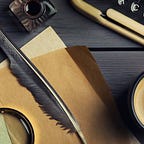COLORS and PAINT-TIPPED BRUSHES🎨: Folk Paintings from India
Rich, divine and ravishing painted portraits 🎨.
This South Asian peninsular country has a treasure chest of rich history, art, culture and heritage. Every one of them portrays a tale of its own, evoking profuse emotions and thoughts, and an immense curiosity and desire to know more. India is truly a country of countless marvels, and its art and culture’s essence- two words- illustrious and august.
The sphere of Indian folk paintings is beyond vibrant and bewitching. And naturally, these painted portraits come in various varieties 😮. The forte of these paintings is that they are astonishingly ancient and have been passed down for generations, say since the 10th century A.D. Now that’s engrossing 🧐🤩! Some renowned varieties of of the transfixing Indian Folk paintings are the Warli Paintings, Madhubani, Kalamkari, Pattachitra, Gond, Tanjore Paintings, Phad, and Miniature paintings.
Every one of these glorious portraits tell a unique and cherished story of its own- stories of India’s rich past, Hindu mythology, historic wars and sometimes, just the daily lives of people of the olden days. Paintings of Hindu gods and goddesses are very common. The vibrant colors used and the innumerous emotions they express make the painting very realistic 🧐.
Since these art forms have been practiced since ancient times, the materials used were usually twigs, brushes and natural dyes. Some, like the Warli paintings have been seen on cave walls in the Ajanta and Ellora caves in Maharashtra. These paintings also prove to be a great interior decor 🎀, as the intricate strokes of brush and the elaborate curves and simple designs prove to be a knockout 🧨!
It’s truly a feast for the eyes. You would be enraptured and taken into the past, as you feel the emotions and story it tries to express. This particular Phad painting shows us Krishna, a Hindu deity and reincarnation of the Hindu god Lord Vishnu, in a garden, accompanied by two women, possibly devotees, spellbound with the aura he possesses and the goodness he spreads.
Gond paintings mostly depict scenes from nature. Other forms of Indian Folk painting, like Miniature, mostly depict scenes from the Mughal rule, as it was influenced by the Islamic style of miniature painting. Indian miniature paintings are influenced by Persian styles, and was prominent during the rule of the Mughals, mainly during the reign of Akbar, who was the third Mughal emperor of India and a great patron of art of literature. Similar to miniature are the Mughal paintings, which are unique combo Indian, Islamic and Persian styles. Lot of cultures in one pot !
This Kalamkari painting also shows us a divine sight of Lord Krishna. Kalamkari is actually an a form of painting cotton textiles, and only natural dyes are used. What’s more mind-boggling and intriguing is that it involves 23 steps to get the final result! As the name says, Kalamkari is crafted using a ‘kalam’ or pen and everything is drawn, painted and worked out by hand. That’s loads of work, but the mesmerizing product of you get is worth it 👍!
These sublime, renowned paintings are seen in temples 📿, in the famed, glorious and historic Indian monuments 👑, and even as decor in Indian homes today.
These sublime, renowned paintings have earned immense admiration, honor and respect over the centuries.
Indian Folk Paintings continue to inspire and add celebrated color, enthusiasm and wonder to India’s historic art and culture 🤩.
